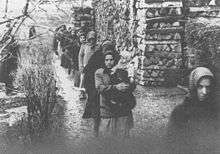Angel Makers of Nagyrév
The Angel Makers of Nagyrév (Hungarian: Tiszazugi méregkeverők, "Tiszazug poison-mixers") were a group of women living in the village of Nagyrév, Hungary who between 1914 and 1929 poisoned to death an estimated 300 people. They were supplied arsenic and encouraged to use it for the purpose by a midwife or "wise woman" named Zsuzsanna Fazekas, wife of Gyula Fazekas, née Zsuzsanna Oláh (Fazekas Gyuláné Oláh Zsuzsanna). Their story is the subject of the documentary film The Angelmakers[1][2][3] and the movie Hukkle.[4]
Angel Makers of Nagyrév | |
|---|---|
Tiszazugi méregkeverők | |
 Location of Nagyrév in Hungary | |
| Nationality | Hungarian |
| Years active | 1914–1929 |
| Criminal charge | murder |
| Penalty | 8 death sentences, only 2 of which were carried out; 12 others imprisoned |
| Details | |
| Target(s) | abusive or unwanted relatives |
| Killed | 40–300 |
| Weapons | arsenic |
Date apprehended | 1929 |
Crimes
Mrs. Fazekas was a middle-aged midwife who arrived in Nagyrév in 1911,[5] with her husband already missing without explanation. Between 1911 and 1921 she was imprisoned 10 times for performing illegal abortions, but was consistently acquitted by judges supporting abortion.
In Hungarian society at that time, the future husband of a teenage bride was selected by her family and she was forced to accept her parents' choice. Divorce was not allowed socially, even if the husband was an alcoholic or abusive.[6] During World War I, when able-bodied men were sent to fight for Austria-Hungary, rural Nagyrév was an ideal location for holding Allied prisoners of war. With POWs having limited freedom within the village, the women living there often had one or more foreign lovers while their husbands were away.[7] When the men returned, many of them rejected their wives' affairs and wished to return to their previous way of life, creating a volatile situation. At this time Fazekas began secretly persuading women who wished to escape this situation to poison their husbands using arsenic made by boiling flypaper and skimming off the lethal residue.[8][9]
After the initial killing of their husbands, some of the women went on to poison parents who had become a burden to them, or to get hold of their inheritance. Others poisoned their lovers, some even their sons; as the midwife allegedly told the poisoners, "Why put up with them?"[10][11]
The first poisoning in Nagyrév took place in 1911; it was not the work of Mrs. Fazekas. The deaths of other husbands, children, and family members soon followed. The poisoning became a fad, and by the mid-1920s, Nagyrév earned the nickname "the murder district." There were an estimated 45–50 murders over the 18 years that Mrs. Fazekas lived in the district. She was the closest thing to a doctor the village had and her cousin was the clerk who filed all the death certificates, allowing the murders to go undetected.[12]
Capture

Three conflicting accounts have been cited to explain how the Angel Makers were eventually detected. In one, Mrs. Szabó, one of the Angel Makers, was caught in the act by two visitors who survived her poisoning attempts. She put a finger on a Mrs. Bukenoveski, who named Mrs. Fazekas. In another account, a medical student in a neighboring town found high arsenic levels in a body that washed up on the riverbank, leading to an investigation. However, according to Béla Bodó, a Hungarian-American historian and author of the first scholarly book on the subject, the murders were finally made public in 1929 when an anonymous letter to the editor of a small local newspaper accused women from the Tiszazug region of the country of poisoning family members.
The authorities exhumed dozens of corpses from the local cemetery.[13] 34 women and one man were indicted. Afterwards, 26 of the Angel Makers were tried, among them Susi Oláh. Eight were sentenced to death but only two were executed. Another 12 received prison sentences.[14]
References
- Astrid Bussink (2006). "The Angelmakers". archive.dokweb.net (in Hungarian and English). Edinburgh College of Art. Archived from the original on 5 July 2017. Retrieved 10 December 2016.
- Sharp, Rob (5 August 2006). "Mirren film brings war tragedy to Yorkshire". The Guardian. Retrieved 10 December 2016.
- International Documentary Film Festival Amsterdam. "The Angelmakers | IDFA". www.idfa.nl. Archived from the original on 20 December 2016. Retrieved 10 December 2016.
- Stephen Holden (5 April 2003). "Film Festival Reviews; Life's Creatures Glow Until Violence Darkens". www.nytimes.com. Retrieved 10 December 2016.
- Heather Sutfin (17 August 2016). "The Angel Makers of Nagyrév". Sword and Scale. Retrieved 10 December 2016.
- Popham, Peter (26 November 2005). "Hungary: Murder on the Danube". The Independent. Retrieved 10 December 2016.
- Katherine Ramsland (3 March 2007). "Angels of Death – Nurses, nurses who kill their patients (Chapter 5, Murder by Proxy)". The Crime library. Archived from the original on 3 March 2007. Retrieved 10 December 2016.
- Fish, Jim (29 March 2004). "BBC NEWS | Europe | Unearthing Hungary husband murders". news.bbc.co.uk. Retrieved 10 December 2016.
- Barry Yeoman (1 November 1999). "Bad Girls". Psychology Today. Sussex Publishers, LLC. Retrieved 10 December 2016.
- Katie Heaney (15 Jul 2014). "11 Terrifying Female Serial Killers You've Never Heard Of". BuzzFeed. Retrieved 10 December 2016.
- http://www.rubicon.hu/magyar/oldalak/arzenes_asszonyok_rendhagyo_sorozatgyilkossag_a_horthy_korban/
- Tonya Blust (12 January 2016). "Creepy crimes from the 1920s". www.historictruecrime.com. Retrieved 10 December 2016.
- "American front in the Hungarian village killer". www.transindex.ro. Index Media Association. 21 May 2004. Retrieved 10 December 2016.
- Bodó, Béla (2002). "The poisoning women of Tiszazug". Journal of Family History. 27 (1): 40–59. doi:10.1177/036319900202700103. PMID 11789522.
Bibliography
- Gregson, Jessica. The Angel Makers. PaperBooks Ltd. 2007. ISBN 0-9551094-6-9.
- Newton, Michael. The Encyclopedia of Serial Killers. 2nd edition. Checkmark Books. 2006. ISBN 0-8160-6196-3. pp. 1–2.
- Bodó, Béla. Tiszazug: A Social History of a Murder Epidemic. Columbia University Press East European Monographs, 2003. ISBN 0-88033-487-8.